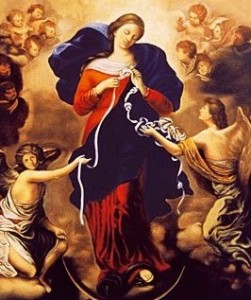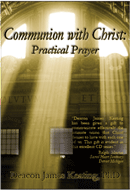The Discerning Hearts Blog
Second day:
Day 1 The Virgin Mary, Untier of Knots Novena – Discerning Hearts
(A brief note why I felt the Novena is so important to promote…you can find the text for Day 1 lower in the post)
Click here for the complete text and audio for the Mary, Untier of Knots Novena
“Eve, by her disobedience, tied the knot of disgrace for the human race; whereas Mary, by Her obedience, undid it…For what the virgin Eve had bound fast through unbelief, this did the Virgin Mary set free through faith.” Saint Irenaeus, in his writings, titled Adversus Haereses (Against Heresies).
I once experienced a situation in which I was totally flummoxed in how to proceed; the result was a tremendous piercing of the heart, all very painful and sad. A large messy misunderstanding arose and the ability to communicate with the other person involved completely disappeared. I wasn’t sure how to pray or even what to pray for, and frankly, it just hurt so much I couldn’t think what to do next. So, like any confused child, I went to my mother for help…our Blessed Mother to be more specific.
As indicated by the great saint above, St. Irenaeus, the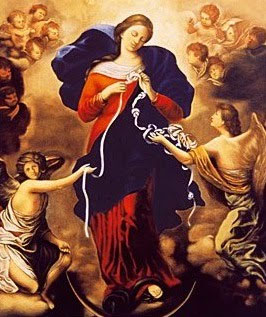 role of Our Lady as the one who “unties” the knots in our lives goes way back to the early years of the Church. The “knots” of course can be anything that separates us from God and our fellow man. And in particular, those knots that tie up and strangle loving relationships in families and friendships.
role of Our Lady as the one who “unties” the knots in our lives goes way back to the early years of the Church. The “knots” of course can be anything that separates us from God and our fellow man. And in particular, those knots that tie up and strangle loving relationships in families and friendships.
The image most closely associated with this devotion was one in the 1700s by an unknown painter. As you can see in the picture, in her hands is a knotted white ribbon, which, with the aid of the angels, she is peacefully untying. All of this is done under the watchful gaze of the Holy Spirit. All the while she is crushing, under her feet, the head of the serpent whose body is coiled and knotted.
In her booklet, Dr. Suzel Frem Bourgerie’s writes about the knots each of us suffers. “How they suffocate the soul, beat us down, betray the heart’s joy and even the will to continue living.” She goes on to say: “… The Virgin Mary does not want this to continue anymore in your life. She comes to you today for you to give her all these snarls because she will undo them one by one.”
In the personal situation that I cited above, I found great comfort and peace knowing that our Blessed Mother was handling everything. I grew to trust in her loving care for the relationship. She, in turn, has taught me to totally trust her Son in all things That was the first knot she needed to untie for me, now she’s working on the others.
Click here for the complete text and audio for the Mary, Untier of Knots Novena
Sign of the Cross
Act of Contrition
First Day
Podcast: Play in new window | Download (Duration: 6:58 — 16.0MB) | Embed
Subscribe: Apple Podcasts | Spotify | Amazon Music | Android | Pandora | iHeartRadio | JioSaavn | Podchaser | Gaana | Podcast Index | Email | TuneIn | Deezer | Anghami | RSS | More
Bible reading:
…« and now she will bear a son. You shall call him ‘Jesus’ for he will save his people from their sins.»
( Mathew 1, 21 )
Brief Reflection:
Our Lord Jesus, was born of the flesh and blood of the Holy Virgin Mary, spouse of the Holy Spirit. Jesus, untied the tongues of the mute, the obstacles to the paralytics, he remove the yoke of the oppressed , and he liberated the sinners with his death. Jesus, through his Death and Resurrection is the Great Untier of Knots of our humanity united to sin. His Mother, first disciple and co re-demptrix, will untie our knots.
( Brief meditation: meditate with one decade of the Holy Rosary: One Our Father, 10 Hail Mary’s, One Glory be and the Prayer to “The Virgin Mary untier of Knots”)
IP#187 Dr. James Hitchcock – The History of the Catholic Church on Inside the Pages
I could have listened to Dr. James Hitchcock all day, he is absolutely fascinating. But the next best thing is to read his tremendous 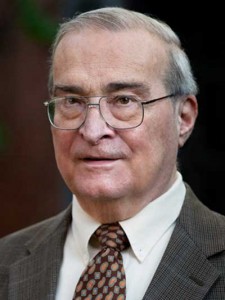 work, “The History of the Catholic Church: From the Apostolic Age to the Third Millennium”. The content is the best, the layout makes it so very accessible, and the storytelling is engaging…a must have and a perfect gift for family and friends! In our discussion, we discuss the influence of the papacy, Constantine, the 13th and 15th century, St. Augustine and St. Thomas Aquinas, and so much more. Not enough time, but so much fun. Don’t miss! One of my favorites of 2012!
work, “The History of the Catholic Church: From the Apostolic Age to the Third Millennium”. The content is the best, the layout makes it so very accessible, and the storytelling is engaging…a must have and a perfect gift for family and friends! In our discussion, we discuss the influence of the papacy, Constantine, the 13th and 15th century, St. Augustine and St. Thomas Aquinas, and so much more. Not enough time, but so much fun. Don’t miss! One of my favorites of 2012!
Podcast: Play in new window | Download (Duration: 4:18 — 3.9MB) | Embed
Subscribe: Apple Podcasts | Spotify | Amazon Music | Android | Pandora | iHeartRadio | JioSaavn | Podchaser | Gaana | Podcast Index | Email | TuneIn | Deezer | Anghami | RSS | More
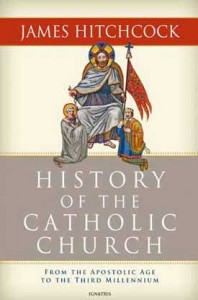 You can find the book here
You can find the book here
“For years, James Hitchcock has been our premier historian – a dissident from conventional wisdom, well-armed and solid. Here he pioneers a new method for presenting a long sweep of history: an orderly and altogether fascinating series of vignettes – of arguments, movements, distinctive persons, and concrete events. There is just enough narrative in these sequences to carry the reader along, but without involving her in excessive interpretation. This book provides both a great resource for easy reference, and a stimulating definition of a Christian humanism that holds in tension the transcendent and the down to earth, the holy and the sinful. This is a tension which Hitchcock maintains throughout.”
– Michael Novak
IP#186 Ann Engelhart – Be Saints! on Inside the Pages
“Be Saints! An invitation from Pope Benedict XVI”, edited by Amy Welborn and illustrated by Ann Engelhart is simply wonderful, a  must for every family library. Marvelous for children and adults alike, this compilation is taken from the talks given by Pope Benedict to children during his 2010 visit to England. In this conversation with Ann Engelhart, we discuss this work. We also discuss the nature of art and beauty, in particular for children, and it’s ability to evangelize.
must for every family library. Marvelous for children and adults alike, this compilation is taken from the talks given by Pope Benedict to children during his 2010 visit to England. In this conversation with Ann Engelhart, we discuss this work. We also discuss the nature of art and beauty, in particular for children, and it’s ability to evangelize.
Podcast: Play in new window | Download (Duration: 27:11 — 49.8MB) | Embed
Subscribe: Apple Podcasts | Spotify | Amazon Music | Android | Pandora | iHeartRadio | JioSaavn | Podchaser | Gaana | Podcast Index | Email | TuneIn | Deezer | Anghami | RSS | More
 You can find the book here
You can find the book here
From the description:
In this very colorful book by acclaimed artist Ann Englehart, the Pope’s words come to life as he interacts with the children, showing all children how only God can satisfy the deepest needs of our hearts.
Interspersed are prayers and quotes from various saints including Saint Francis, Saint Ignatius, Mother Teresa, St. Paul, St. Peter and more. They all emphasize that the most important thing we can become in this life is a Saint, a true friend of Jesus.
IP#184 Fr. Joe Kempf – No One Cries the Wrong Way on Inside the Pages
Fr. Joe Kempf has given us two excellent resources for both adults and kids to help us deal with loss. Fr. Joe really understands the 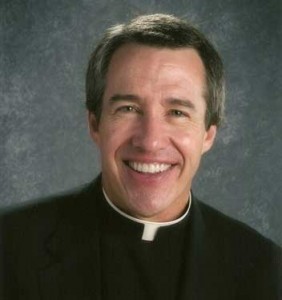 grieving process and offers excellent advice for those at any stage of that journey.
grieving process and offers excellent advice for those at any stage of that journey.
Podcast: Play in new window | Download (44.9MB) | Embed
Subscribe: Apple Podcasts | Spotify | Amazon Music | Android | Pandora | iHeartRadio | JioSaavn | Podchaser | Gaana | Podcast Index | Email | TuneIn | Deezer | Anghami | RSS | More
You can find this book here
Cardinal Timothy Dolan of New York says this about Fr. Kempf’s books: “Fr. Kempf, with grace and sensitivity, helps us learn what to say – and do – in moments when people long for a word of hope and consolation.”
You can find this book here
From the description:
When the heartaches come, these reflections, prayers, and activities will help every child find their way forward with God. In the back of the book, parents, grandparents, and teachers will find the coaching they need to love their children through the difficult times.
This wonderfully illustrated book meets the child (and the child in each of us) right where we are with just what we need. No one connects faith and real life like Fr. Joe and Big Al. Sometimes Life is Just Not Fair is the perfect book for when the difficult times come…and they visit us all.
WOM#12 – The Liturgy of the Eucharist part 4: the Communion Rite – The Way of Mystery with Deacon James Keating episode 12 – Discerning Hearts
Episode 12 -The Way of Mystery: The Eucharist and Moral Living– The Liturgy of the Eucharist part 4 : the Communion Rite…The moment of radical surrender…can we do it? We when come forward to communion, what are doing…what are we saying? Will we allow ourselves to be transformed? The moment of silence…will we allow ourselves to be transformed within so we can go out to transform the culture for Christ?
Podcast: Play in new window | Download (Duration: 28:21 — 26.0MB) | Embed
Subscribe: Apple Podcasts | Spotify | Amazon Music | Android | Pandora | iHeartRadio | JioSaavn | Podchaser | Gaana | Podcast Index | Email | TuneIn | Deezer | Anghami | RSS | More
Deacon James Keating, PhD, the director of Theological Formation for the Institute for Priestly Formation, located at Creighton University, in Omaha, is making available to ”Discerning Hearts” and all who listen, his series of programs entitled “The Way of Mystery”.
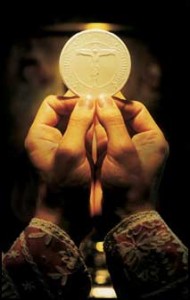 The Vatican II documents remind us that the spiritual journey is not made in a vacuum, that God has chosen to save us, not individually, but as The People of God. The Eucharist must help Christians to make their choices by discerning out of Christ’s paschal mystery. For this process to take place, however, Christians must first understand how the Eucharist puts them in touch with Christ’s passion, death, and resurrection, and what concrete implications being in touch with this mystery has for their daily lives.
The Vatican II documents remind us that the spiritual journey is not made in a vacuum, that God has chosen to save us, not individually, but as The People of God. The Eucharist must help Christians to make their choices by discerning out of Christ’s paschal mystery. For this process to take place, however, Christians must first understand how the Eucharist puts them in touch with Christ’s passion, death, and resurrection, and what concrete implications being in touch with this mystery has for their daily lives.
For more information on the “Institute of Priestly Formation” and for other material available by Deacon Keating, just click here
Don’t forget to pickup a copy of “Communion with Christ” , it is one of the best audio sets on prayer…ever!
St. John of the Cross – Purify the heart in order to meet Christ
VATICAN CITY, 16 FEB 2011 (VIS) – In his general audience today, held in the Paul VI Hall, the Pope focused his attention on St. John of the Cross, “spiritual friend to St. Teresa and, with her, reformer of the Carmelite religious family. Proclaimed a Doctor of the Church by Pius XI in 1926, he is traditionally known as the ‘Doctor mysticus’, the Mystical Doctor”, the Holy Father said.
John was born to a poor family at Fontiveros near the Spanish town of Avila in 1542 and entered the Carmelite order at Medina del Campo. Ordained a priest in 1567, it was on the occasion of his first Mass that he met Teresa, “who explained to him her plan for the reform of the Carmelites”. In his renewal of his religious profession John took the name “of the Cross” and collaborated enthusiastically in the process of reform, something “which brought him great suffering”, and even led to his imprisonment following an unjust accusation. While preparing a journey to Mexico he fell seriously ill and died in December 1591. He was beatified by Clement X in
1675 and canonised by Benedict XIII in 1726.
St. John of the Cross, said Benedict XVI, “is considered one of most important lyric poets of Spanish literature. He wrote four major works: ‘Ascent of Mount Carmel’, ‘Dark Night of the Soul‘, ‘Spiritual Canticle’ and ‘Living Flame of Love‘.
“In his ‘Spiritual Canticle’ St. John outlines the soul’s journey of purification”, the Holy Father added. “The ‘Living Flame of Love’ continues in the same line, describing in greater detail the condition of union with God. … ‘Ascent of Mount Carmel’ outlines the spiritual itinerary from the point of view of a progressive purification of the soul, which is necessary in order to scale the heights of Christian perfection, symbolised by the summit of Mount Carmel”.
The Pope continued his catechesis by explaining how “the ‘Dark Night of the Soul’ describes the ‘passive’ aspect; in other words, God’s contribution to the process of purifying the soul. Human effort alone, in fact, is incapable of reaching the deepest roots of a person’s bad inclinations and habits. It can halt them but not eradicate them completely. To do this, we need a special action by God which radically purifies the spirit and disposes it to the union of love with Him“.
“The rate of increase of faith, hope and charity goes hand in hand with the work of purification and with progressive union with God, until attaining transformation into Him. When this goal is reached, the soul is immersed in Trinitarian life itself. … This is why the Mystical Doctor held that there is no true union of love with God that does not culminate in Trinitarian union”.
The Pope completed his remarks by asking whether the life of St. John of the Cross has anything to say to everyday Christians, or whether it is an example only for the few select souls who can follow the path of purification and mystical ascesis. “The journey with Christ, travelling with Christ … is not an additional weight to the already sufficiently-heavy burden of our lives”, he said. “It is something totally different. … It is a light, a power which helps us carry our everyday burden. … Allowing ourselves to be loved by Christ is the light which helps us to carry the daily burden, and sanctity is not a task we must accomplish on our own, a very difficult task. … Let us ask God to help us become saints, to allow ourselves to be loved by God, which is the vocation and true redemption of us all”.
Published by VIS – Holy See Press Office – Wednesday, February 16, 2011
Our Lady of Guadalupe “Do you not know that I am your Mother” – a reflection with Msgr. John Esseff – Discerning Hearts
Podcast: Play in new window | Download (Duration: 28:32 — 52.3MB) | Embed
Subscribe: Apple Podcasts | Spotify | Amazon Music | Android | Pandora | iHeartRadio | JioSaavn | Podchaser | Gaana | Podcast Index | Email | TuneIn | Deezer | Anghami | RSS | More
“Do you not know I am your Mother?” Msgr. Esseff reflects on the Great Mother of God, Mary Most Holy…Our Lady of Guadalupe. First, 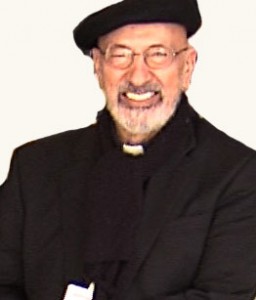 he discusses the image itself that was left for all of us. Then he talks about our relationship with her today!
he discusses the image itself that was left for all of us. Then he talks about our relationship with her today!
Ps 1:1Rv 11:19a; 12:1-6a, 10ab
and the ark of his covenant could be seen in the temple.A great sign appeared in the sky, a woman clothed with the sun,
with the moon under her feet,
and on her head a crown of twelve stars.
She was with child and wailed aloud in pain as she labored to give birth.
Then another sign appeared in the sky;
it was a huge red dragon, with seven heads and ten horns,
and on its heads were seven diadems.
Its tail swept away a third of the stars in the sky
and hurled them down to the earth.
Then the dragon stood before the woman about to give birth,
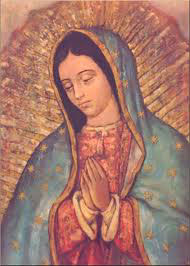
to devour her child when she gave birth.
She gave birth to a son, a male child,
destined to rule all the nations with an iron rod.
Her child was caught up to God and his throne.
The woman herself fled into the desert
where she had a place prepared by God.Then I heard a loud voice in heaven say:
“Now have salvation and power come,
and the Kingdom of our God
and the authority of his Anointed.”
WOM#11 – The Liturgy of the Eucharist part 3: The Eucharistic Prayer – The Way of Mystery with Deacon James Keating episode 11 – Discerning Hearts
Episode 11 -The Way of Mystery: The Eucharist and Moral Living– The Liturgy of the Eucharist part 3 : The Eucharistic Prayer…God teaching us to pray. What are we doing in our participation and are we truly ready to receive the Body of Christ? Should we, in integrity, receive the Truth of Christ in Communion…do we really believe?
Podcast: Play in new window | Download (Duration: 28:18 — 25.9MB) | Embed
Subscribe: Apple Podcasts | Spotify | Amazon Music | Android | Pandora | iHeartRadio | JioSaavn | Podchaser | Gaana | Podcast Index | Email | TuneIn | Deezer | Anghami | RSS | More
Deacon James Keating, PhD, the director of Theological Formation for the Institute for Priestly Formation, located at Creighton University, in Omaha, is making available to ”Discerning Hearts” and all who listen, his series of programs entitled “The Way of Mystery”.
 The Vatican II documents remind us that the spiritual journey is not made in a vacuum, that God has chosen to save us, not individually, but as The People of God. The Eucharist must help Christians to make their choices by discerning out of Christ’s paschal mystery. For this process to take place, however, Christians must first understand how the Eucharist puts them in touch with Christ’s passion, death, and resurrection, and what concrete implications being in touch with this mystery has for their daily lives.
The Vatican II documents remind us that the spiritual journey is not made in a vacuum, that God has chosen to save us, not individually, but as The People of God. The Eucharist must help Christians to make their choices by discerning out of Christ’s paschal mystery. For this process to take place, however, Christians must first understand how the Eucharist puts them in touch with Christ’s passion, death, and resurrection, and what concrete implications being in touch with this mystery has for their daily lives.
For more information on the “Institute of Priestly Formation” and for other material available by Deacon Keating, just click here
Don’t forget to pickup a copy of “Communion with Christ” , it is one of the best audio sets on prayer…ever!
IP#182 Dr. Christopher Kaczor – The Seven Big Myths About the Catholic Church on Inside the Pages
“The Seven Big Myths About the Catholic Church: Distinguishing Fact from Fiction about Catholicism” by Dr. Christopher Kaczor is a 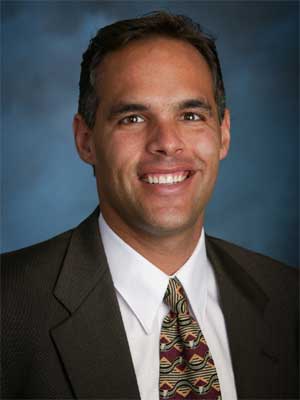 must have resource for Catholics!
must have resource for Catholics!
The misconceptions about our faith are so prevalent in today’s society that is almost guaranteed that you will encounter at least one of these myths in daily conversations with friends, co-workers, and sadly to say, family members. To have the peace of mind, in order to answer the objection, is invaluable, especially when we are called to the New Evangelization. But even more than that, Dr. Kaczor helps us to give a reason for our hope…the presence of Jesus Christ and His saving grace and mercy found in our Roman Catholic faith.
Podcast: Play in new window | Download (51.2MB) | Embed
Subscribe: Apple Podcasts | Spotify | Amazon Music | Android | Pandora | iHeartRadio | JioSaavn | Podchaser | Gaana | Podcast Index | Email | TuneIn | Deezer | Anghami | RSS | More
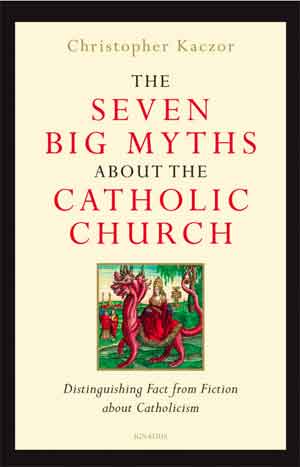 You can find the book here
You can find the book here
The Seven Myths:
The Church Opposes Science: The Myth of Catholic Irrationality
The Church Opposes Freedom and Happiness: The Myth of Catholic Indifference to Earthly Welfare
The Church Hates Women: The Myth of Catholic Misogyny
Indifferent to Love, the Church Banned Contraception: The Myth of Opposition between Love and Procreation
The Church Hates Gays: The Myth of Catholic “Homophobia”
The Church Opposes Same-Sex Marriage Because of Bigotry: The Myth That There Is No Rational Basis for Limiting Marriage to One Man and One Woman
Priestly Celibacy Caused the Crisis of Sexual Abuse of Minors: The Myth of Priestly Pedophilia
“All of this book is full of clarity and charity, but two chapters are masterpieces, each worth ten times the price of the whole book. The chapter on contraception is the most simple, commonsensical, winsome and persuasive I have ever seen. It could have been written only by a very good and wise husband and father. The chapter on same-sex marriage has the clearest and the completest logic I have ever read on the subject.” —Peter Kreeft, Boston College

